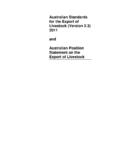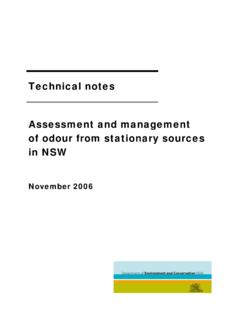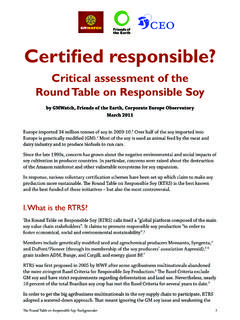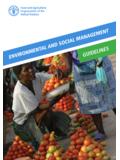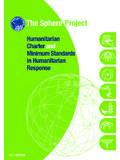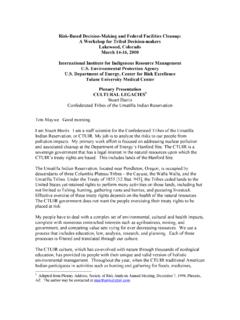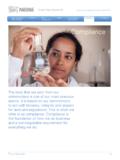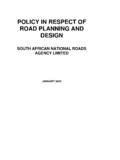Transcription of A value chain approach to animal diseases risk …
1 ISSN 1810-0708. 4. FAO animal PRODUCTION AND HEALTH. guidelines A value chain approach TO. animal diseases . RISK management . Technical foundations and practical framework for eld application Cover photographs: Left: @FAO/Hoang Dinh Nam Center: FAO/Peter Roeder Right: Kimoto 4. FAO animal PRODUCTION AND HEALTH. guidelines A value chain approach TO. animal diseases . RISK management . Technical foundations and practical framework for eld application FOOD AND AGRICULTURE ORGANIZATION OF THE UNITED NATIONS. Rome, 2011. Recommended Citation FAO. 2011. A value chain approach to animal diseases risk management Technical foundations and practical framework for eld application. animal Production and Health Guidelines. No. 4. Rome. The designations employed and the presentation of material in this information product do not imply the expression of any opinion whatsoever on the part of the Food and Agriculture Organization of the United Nations (FAO) concerning the legal or development status of any country, territory, city or area or of its authorities, or concerning the delimitation of its frontiers or boundaries.
2 The mention of specific companies or products of manufacturers, whether or not these have been patented, does not imply that these have been endorsed or recommended by FAO in preference to others of a similar nature that are not mentioned. ISBN 978-92-5-106861-8. All rights reserved. FAO encourages reproduction and dissemination of material in this information product. Non-commercial uses will be authorized free of charge, upon request. Reproduction for resale or other commercial purposes, including educational purposes, may incur fees. Applications for permission to reproduce or disseminate FAO copyright materials, and all queries concerning rights and licences, should be addressed by e-mail to or to the Chief, Publishing Policy and Support Branch, Office of Knowledge Exchange, Research and Extension, FAO, Viale delle Terme di Caracalla, 00153 Rome, Italy.
3 FAO 2011. iii Contents Acknowledgements vii Acronyms and abbreviations viii Summary ix PART 1. Technical Foundations Why a value chain approach to management of disease risks ? 1. Risk-based, people-centred control of disease risks in livestock value chains 1. Systematic thinking a basis for transparent and evidence-based planning 3. value chains and value chain analysis for the purposes of management of animal disease risks 7. What are value chains? 7. value chain analysis 9. Summary 13. Risk Analysis 15. Risk analysis key concepts and principles 15. The value of qualitative risk analysis 21. PART 2. Practical Framework Step 1: Situation analysis and preliminary risk analysis 25. Descriptive epidemiology of the situation regarding the disease (s) of concern 25. Carrying out value chain analysis 25.
4 Identifying risk issues and risk hotspots in value chains 30. Step 2: Detailed risk and value chain analysis leading to planning of risk management options 39. Detailed risk analysis focused on risk hotspots 39. iv Step 3: Option appraisal and design of strategy 51. Analysis of impacts on different stakeholders 52. Choice of interventions decision-making criteria 54. Concluding remarks 59. ANNEX 1. Risk pathway analysis and risk control 63. Risk pathway analysis 63. Risk control using risk pathways to identify risk control points 71. ANNEX 2. Developing and analysing enterprise budgets 75. Objectives 75. Developing an enterprise budget analysis 75. Notes of caution 83. ANNEX 3. Outline for information gathering on poultry value chain 85. Objective 85. Diagrams and maps 86. Points to remember: 86.
5 Example of an outline for a workshop with government veterinary services and livestock and trade staff at province level 87. ANNEX 4. Semi-structured interview guides for different poultry-related sites 89. Feed plants 89. Grand parent and parent flocks 90. Hatcheries 94. Commercial poultry farms 97. Traders 101. Markets, collection points (where trading may take place), dealers premises 102. Slaughter points/houses 106. Village poultry, household poultry, backyard poultry, non-commercial poultry (perhaps defined as flocks of up to 20 or 50 maximum) 108. v ANNEX 5. Example of a preliminary risk analysis table for risk of foot- and-mouth disease (FMD) in northern Viet Nam 109. ANNEX 6. Example of a detailed risk assessment and risk mitigation analysis Viet Nam 113. References 123. Tables 1.
6 Template for a preliminary risk analysis table 36. 2. Template for detailed descriptive risk assessment 47. 3. An example of a part of a detailed descriptive risk assessment addressing risk of spreading FMD within a country 48. 4. Tabular framework for analysis of impacts on different stakeholders 54. 5. Tabulation of a risk pathway analysis for the risk of importing pigs infected with classical swine fever (CSF) virus 67. 6. Seasonal calendar format to develop a participatory enterprise budget 76. 7. Estimation of the annual output for a small scale hen egg laying enterprise 76. 8. Estimation of the variable costs for a small scale hen egg laying enterprise 77. 9. Estimation of the labour costs for a small scale hen egg laying enterprise 78. 10. Estimation of the fixed costs for a hen egg laying enterprise 80.
7 11. Estimation of the gross margin and enterprise profit for hen egg laying enterprise 81. 12. Cost structure of the hen laying enterprise 82. 13. Estimation of the cost and profit per egg of the different people in an egg chain . 83. 14. Example of a preliminary risk analysis table for risk of foot and mouth disease (FMD) in Northern Viet Nam 110. Figures 1. Cyclical disease management xii 2. Linking value chain analysis with epidemiology and risk analysis in disease control planning and management 4. 3. A schematic value chain 7. 4. Generic framework for livestock value chain 10. vi 5. Generic meat chicken value chain framework 11. 6. The four components of risk analysis 16. 7. Different ways of assessing the importance of different branches of a livestock value chain or a system. 29.
8 8. An example of a diagram of a risk pathway to address the risk of an outbreak of classical swine fever (CSF) in a pig farm as a result of feeding waste food 40. 9. Example of using a risk pathway diagram to graphically explore the risk factors in order to identify areas where risk reduction measures might be applied risk of transmitting H5N1 HPAI. through a hatchery 43. 10. Pathway for a simple import risk assessment 63. 11. Risk pathway for inter-farm transmission of an infectious poultry disease ( H5N1 HPAI) 64. 12. Qualitative risk assessment scheme used by Defra in the UK. (Defra, 2002) 69. Boxes 1. Compartmentalization 2. 2. The four components of risk analysis 15. 3. The three fundamental principles of contagious disease control 18. 4. Summary of principles of risk analysis 20.
9 5. Example of qualitative risk analysis for HPAI 22. 6. Checklists of items to consider in value chain description and analysis 31. 7. disease spread, risky practices and risk hotspots in value chains 34. 8. Reducing the contact rate in value chains [suggestions] 45. 9. Broad categorization of biosecurity measures applicable in livestock value chains 46. 10. Checklist of factors to consider when trying to assess the likelihood that a risk reduction measure will be complied with by farmers/ traders/ food handlers 56. 11. H5N1 HPAI virus spread mechanisms 65. 12. Some factors affecting likelihood of disease transmission ( H5N1 HPAI) 66. vii Acknowledgements These guidelines were written on behalf of the Food and Agriculture Organization of the United Nations (FAO) under the overall guidance and responsibility of Dr J.
10 Lubroth, Chief Veterinary Officer, FAO. The main authors were Mr Nick Taylor, Veterinary Epidemiology and Economics Research Unit (VEERU) at the University of Reading and Dr Jonathan Rushton, animal Health Economist in Veterinary Epidemiology and Public Health Group, Royal Veterinary College, United Kingdom. This document has been reviewed and coordinated by Dr Julio Pinto (Veterinary Epidemiologist), FAO animal Health Officer, Emergency Prevention System/Global Early Warning System (EMPRES/GLEWS) and Dr Nicoline de Haan, FAO Socio-economist, Emergency Centre for Transboundary animal diseases (ECTAD). Publication of this document was made possible by financial support from FAO, Canadian International Development Agency (CIDA) and Wellcome Trust. viii Acronyms and abbreviations CSF Classical Swine Fever DEFRA Department for Environment, Food and Rural Affairs (UK).










